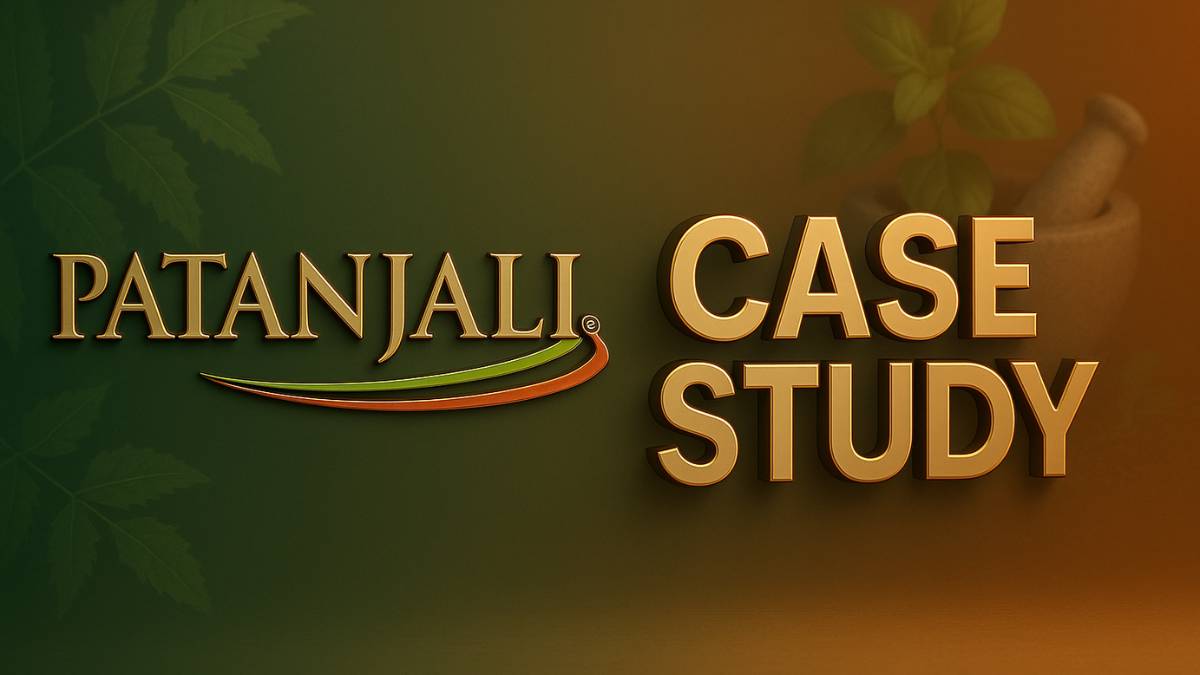Every once in a while, a brand comes along that rewrites the rules of an entire industry. Patanjali Ayurved is one of those rare names. It didn’t just enter India’s cluttered FMCG space, it disrupted it.
Table of Contents
From the outside, it may look like another consumer goods brand riding the wave of Ayurveda. But in reality, Patanjali is a case of cultural relevance meeting sharp business instinct.
For marketers, startup founders, and anyone trying to build a consumer brand in India, studying Patanjali case study is like getting an insider look into how grassroots trust, speed, and identity can outmaneuver even the biggest multinationals. Let’s explore how it all began.
Founding of Patanjali Ayurved: The Vision Behind the Brand
The roots of Patanjali go back to two individuals, Baba Ramdev and Acharya Balkrishna. Ramdev was already a household name due to his televised yoga sessions. Balkrishna, his close associate, brought in the Ayurvedic knowledge and business acumen.
The original vision was fairly straightforward: create affordable Ayurvedic products and make them accessible to the masses. But what made it unique was the scale and conviction with which this vision was pursued.
This wasn’t just about launching a few herbal soaps or toothpaste options. It was about redefining wellness as a way of life, rooted in Indian tradition but delivered with modern-day convenience.
By the mid-2000s, the duo had laid the foundation for what would become Patanjali Ayurved. Over the years, the brand went from a few SKUs in local stores to a nationwide presence spanning almost every FMCG category imaginable.
Patanjali’s Growth Trajectory: From Yoga to Supermarket Shelves
Patanjali’s story is closely tied to Baba Ramdev’s personal brand. His morning yoga shows were watched by millions, and they acted as an unintentional soft launchpad for Patanjali products.
As trust in Ramdev grew, so did curiosity about the products he endorsed. In an age where influencer marketing was still new, this was a masterclass in personal brand-led product strategy.
By 2010–11, Patanjali’s revenue was estimated at around ₹1,000 crore. Just six years later, in 2016–17, this jumped to over ₹10,500 crore, reflecting the explosive pace at which it captured market share and consumer trust. (Source)
Year after year, Patanjali expanded its product range and retail footprint at a pace that caught competitors off guard. It moved from niche Ayurvedic shelves to becoming a staple in middle-class homes.
There were key inflection points, product launches that hit the right chord, shifts in consumer behavior, and an increased appetite for “Swadeshi” goods. Each of these moments added to Patanjali’s momentum.
Also Read: Netflix Case Study
Brand Positioning & Identity: How Patanjali Stood Out
At its core, Patanjali positioned itself as more than just a product line. It was a cultural movement. Its emphasis on being Swadeshi, Ayurvedic, and rooted in Indian heritage made it feel less like a brand and more like a cause.
In a market dominated by foreign brands with glossy campaigns, Patanjali’s earthy, raw, almost humble presentation struck a different chord. It didn’t need to scream premium. It whispered purity.
For example, Patanjali’s Dant Kanti captured around 14% of the toothpaste market by 2018, significantly disrupting the dominance of legacy players like Colgate. (Source)
The timing was crucial too. A wave of nationalism and pride in Indian traditions was on the rise. Patanjali rode that wave by giving people a tangible way to express their identity through everyday purchases.
Suddenly, choosing a toothpaste or cooking oil wasn’t just about price or performance. It was a statement.
Also Read: Advanced Digital Marketing Course in Panchkula
Marketing Strategy of Patanjali
1. Baba Ramdev: The Relatable Brand Ambassador
One of Patanjali’s greatest marketing assets was Baba Ramdev himself. He wasn’t a celebrity in the conventional sense, but he had something more powerful: trust.
People saw him as someone who cared about their health. That perception extended to the products he vouched for. Unlike polished actors reading from scripts, Ramdev spoke with conviction. That authenticity mattered.
2. Non-Traditional Advertising
Patanjali largely skipped conventional advertising in its early years. Instead, it relied heavily on word of mouth, news media coverage, and Baba Ramdev’s reach through yoga camps and TV shows.
This approach gave the brand a grassroots feel. It wasn’t selling to you; it was suggesting better choices. And that tone of voice resonated.
3. Product Packaging & Pricing
You’d rarely find glossy finishes or Westernised visuals on Patanjali products. The look was earthy, the fonts were bold and clear, and the messaging was simple. Everything about it signaled accessibility.
Price played a big role too. Patanjali undercut many existing players by offering more affordable options, without compromising on perceived health benefits. This value-driven approach helped win over price-sensitive consumers.
4. Retail Strategy
Rather than rely solely on existing retail chains, Patanjali created its own network of dedicated stores. These outlets not only pushed sales but also created a controlled brand experience.
Eventually, the brand expanded to general trade stores, supermarkets, and e-commerce platforms, but the initial base of own-brand stores gave it an edge in early-stage visibility.

Enroll Now: Advanced Digital Marketing Course
Product Strategy of Patanjali: Diversification at Scale
Once Patanjali had established trust, it didn’t wait around. The brand aggressively entered new categories, from personal care and packaged foods to Ayurvedic medicines and home cleaners.
This diversification wasn’t random. Most of the products were tied to wellness and daily essentials. So while it looked like the brand was expanding fast, it was actually moving deeper into the consumer’s everyday life.
And that became its strength. If you used Patanjali toothpaste in the morning, there was a good chance you’d end up cooking with its ghee or washing your clothes with its detergent too.
Patanjali Cow Ghee became one of its top-selling products, and helped it gain a sizable share in the branded ghee market, even challenging established names like Amul.
Speed also played a role. While larger companies took months to launch, Patanjali could get a new product to market quickly, test response, and iterate fast.
Also Read: Myntra Case Study
Digital & E-commerce Play: A Late but Strategic Entry
Patanjali wasn’t among the early adopters of digital marketing. Its core audience initially came from TV, print, and on-ground interactions.
But as the market evolved, the brand adapted. It began showing up on marketplaces like Amazon and Flipkart, and eventually launched its own D2C platform.
YouTube also became a strong channel, not just for ads, but for educational content around Ayurveda and wellness. This helped Patanjali connect with a younger, digitally-savvy demographic without abandoning its roots.
In many ways, its digital presence echoed its offline journey: simple, direct, and focused on trust.
Also Read: Uniqlo Case Study
Supply Chain & Manufacturing: A Massive Backend Operation
One of Patanjali’s underrated strengths lies in its supply chain. The brand has invested heavily in its own manufacturing units, giving it more control over quality and scalability.
By sourcing ingredients directly from local farmers, Patanjali created a symbiotic relationship that ensured both supply chain efficiency and rural economic impact.
This localised procurement strategy also supported its Swadeshi narrative. The ability to manage production in-house, at scale, allowed them to keep costs low and react quickly to market demands.
Also Read: Amul Case Study
Controversies & Challenges: What Almost Derailed Patanjali
Despite its success, Patanjali has faced its fair share of challenges. Some of its products have come under fire for not meeting expected quality standards. There were also instances of regulatory pushback and legal scrutiny over exaggerated claims in advertisements.
Another issue was brand dilution. At one point, it felt like there was a Patanjali version of almost everything. That rapid expansion, while impressive, made it harder for the brand to maintain consistency across categories.
Public trust took minor hits, but the core consumer base largely stuck around, partly because of the strong cultural and emotional connect.
Also Read: Starbucks Case Study
Strategic Acquisitions & Partnerships
One of the boldest moves by Patanjali was acquiring Ruchi Soya. This was a game-changer. It gave Patanjali a foothold in the edible oil market, one of the largest consumer categories in India.
Through this acquisition, the company also gained access to Ruchi’s distribution and production infrastructure, boosting its backend significantly.
Later, Patanjali Foods became the umbrella under which it could grow into new packaged food segments. The company also began tapping into capital markets, marking a transition from a mission-led startup to a financially sophisticated enterprise.
Also Read: Zomato Case Study
Comparison with Rivals: How Patanjali Changed FMCG in India
Before Patanjali, few Indian brands were challenging giants like HUL, Colgate, or Nestlé head-on. But that changed.
Patanjali disrupted entire product categories. Its toothpaste gave Colgate a scare. Its ghee competed with Amul. Even its noodles sparked reactions from giants who had ruled the space for decades.
This impact wasn’t always about market share. Sometimes, the bigger win was changing how legacy brands communicated, suddenly, everyone wanted to appear more Indian, more natural, and more affordable.
It also opened the floodgates for other Ayurveda-based startups. In a way, Patanjali became the catalyst for an entire wave of wellness-led brands.
Also Read: Coca-Cola Case Study
Lessons for Marketers & Founders
So, what should marketers and founders take away from this?
1. Trust > Ads: Patanjali built trust long before it spent on traditional media. For new brands, focus on winning hearts before wallets.
2. Speed is a weapon: Many legacy brands lost ground simply because they moved slower. If you can test, iterate, and launch quickly, you can outpace the big guys.
3. Culture connects: Aligning your brand with cultural values creates more than customers, it builds loyal advocates.
4. Omni-channel means presence AND perception: Being online or offline isn’t enough. The brand message, price point, and trust need to align across all touchpoints.
Also Read: McDonald’s Case Study
Where Patanjali Stands in 2025: Future Outlook
As of 2025, Patanjali is not just a brand, it’s a business ecosystem. With Patanjali Foods now listed and other verticals gaining momentum, the company has matured into a full-scale FMCG conglomerate.
But challenges remain. New-age Ayurveda startups are gaining traction. Consumers are also more discerning now, and loyalty can be fickle.
To stay ahead, Patanjali will need to strike a balance between scale and depth, innovation and tradition, trust and performance.
Also Read: Amazon Case Study
Conclusion
Patanjali’s journey shows that you don’t need to play by old rules to win. If your vision is clear, your execution is fast, and your brand connects emotionally, you can rewrite the game.
For digital marketers, brand strategists, and founders, this is more than a case study. It’s a blueprint for what’s possible when purpose meets performance.
FAQs: Patanjali Case Study
1. Who is the founder of Patanjali Ayurved and what was the brand’s vision?
Patanjali was co-founded by Baba Ramdev and Acharya Balkrishna. Their vision was to make Ayurvedic wellness accessible and affordable to the masses.
2. How did Patanjali grow so fast in India’s FMCG sector?
A combination of trust in Baba Ramdev, product affordability, and fast execution helped the brand scale rapidly across categories.
3. What marketing strategies made Patanjali successful?
Non-traditional marketing, personal branding, grassroots awareness through yoga camps, and minimal ad spend in early years made it stand out.
4. How does Patanjali differentiate itself from multinational competitors?
By focusing on Swadeshi values, Ayurveda, and accessible pricing, Patanjali positioned itself as culturally rooted and trustworthy.
5. What challenges or controversies has Patanjali faced over the years?
Issues with product quality, regulatory actions, and brand dilution due to excessive diversification have been major challenges.
6. What can modern marketers learn from the Patanjali case study?
Build brand trust, move quickly, connect culturally, and don’t underestimate the power of simplicity and purpose.

